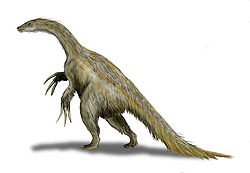Nothronychus
| Nothronychus Temporal range: Late Cretaceous,
| |
|---|---|

| |
| Head and neck of a mounted Nothronychus skeleton cast | |
| Scientific classification | |
| Kingdom: | |
| Phylum: | |
| Class: | |
| Superorder: | |
| Order: | |
| Suborder: | |
| Superfamily: | |
| Genus: | Nothronychus Kirkland & Wolfe, 2001
|
| Species | |
| |
Nothronychus is a genus of dinosaur classified in the group Therizinosauria, strange herbivorous theropods with a toothless beak, a bird-like hip (resembling the non-related ornithischians) and four-toed feet, with all four toes facing forward. The type species of this dinosaur was found by Kirkland and Douglas G. Wolfe in 2001 near New Mexico's border with Arizona, in an area known as the Zuni Basin. It was recovered from rocks assigned to the Moreno Hill Formation, dating to the late Cretaceous period (mid-Turonian stage), about 90 million years ago.
The name Nothronychus, derived from Greek meaning 'sloth-like claw', was selected because the animal reminded Kirkland of a giant ground sloth.
Description
Nothronychus is a member of the theropod group of carnivorous dinosaurs that includes Tyrannosaurus but Nothronychus, and its close relatives, evolved into plant-eaters. It was bipedal and walked more upright than its carnivore ancestors. The creature weighed about a tonne, was 4.5-6 m (15-20 ft) long and stood 3-3.6 m (10-12 ft) tall. Nothronychus was larger than Erlikosaurus or Segnosaurus but in some ways more primitive than these Asian relatives.
A reconstruction of 40 to 50 percent of its skeleton, from two separate species, allows scientists to describe these dinosaurs as having a small head with a mouth full of leaf-shaped teeth, adapted for shredding vegetation,
- a long, thin neck,
- long arms with dexterous hands and 10 cm (4 in) curved claws on its fingers,
- a large abdomen,
- stout back legs and
- a relatively short tail.
Discovery and species
The first fossil evidence later attributed to Nothronychus was discovered by a team of paleontologists working in the Zuni Basin of New Mexico. A therizinosaur illium (hip bone) had originally been mistaken for a part of the crest of the newly discovered ceratopsian Zuniceratops. However, closer examination revealed the true identity of the bone, and soon more parts of the skeleton were found. The New Mexico team, lead by paleontologists Jim Kirkland and Doug Wolfe, published their find in the Journal of Vertebrate Paleontology on 22 August 2001, making it the type specimen of the new species Nothronychus mckinleyi.[1] The Arizona Republic newspaper, however, was first to announce the name on 19 June 2001, in a column by R.E. Molnar.
A second, more complete therizinosaur specimen was discovered in 1999 by Merle Graffam, a resident of Big Water, Arizona. The area around Big Water had been subject to several expeditions by teams from the Museum of Northern Arizona (MNA), and was known for its abundance of marine reptile fossils, especially plesiosaurs.[2] During part of the late Cretaceous period, the region had been submerged under a shallow sea, the Western Interior Seaway, and preserves extensive marine deposits. Graffam's initial discovery (a large, isolated toe bone) came as a surprise to scientists, as it clearly belonged to a land-dwelling dinosaur, rather than a plesiosaur. However, the location of the bone at the time would have been nearly 100 kilometers from the Cretaceous shoreline. An excavation of the area by an MNA crew revealed more of the skeleton, and the scientists found that it was a therizinosaur, and the first example of that group to be found in the Americas. All previous therizinosaur fossils had come from China and Mongolia.[1]
The specimen studied by the MNA team in Arizona was found to be closely related to N. mckinleyi, though it differed in build (being heavier) and age (about half a million years older).[2] The MNA specimen was classified as the new species Nothronychus graffami by Lindsay Zanno and colleagues in the journal Proceedings of the Royal Society B on 15 July 2009. N. graffami was named for Graffam, who discovered the original specimens.[3] A reconstructed skeleton of N. graffami went on display at the MNA in September 2007.[2]
Paleobiology and paleoecology

Bird-like characteristics and preserved feathers in fossils of its Asian relative Beipiaosaurus indicate Nothronychus may have had a primitive coat of feathers consisting of both short, down-like fibers as well as long, quill-like bristles. No feather impressions were found with the fossil remains, probably because the surrounding sediment was unable to preserve such delicate features.
The sloth-like Nothronychus lived in swampy forests similar to the modern bayous in Louisiana. The era was a period of extreme global warming, with ocean levels 300 m (1,000 ft) higher than current levels and a significantly reduced amount of dry land. Almost no dinosaur fossils have been found from this time, particularly in North America, making this and associated discoveries very important.
References
- ^ a b Kirkland, J.I., and Wolfe, D.G. (2001). "First definitive therizinosaurid (Dinosauria; Theropoda) from North America." Journal of Vertebrate Paleontology, 21(3): 410-414.
- ^ a b c Gillette, D.D. (2007). "Therizinosaur: Mystery of the Sickle-Clawed Dinosaur." Arizona Geology, 37(2): 1-6. pdf available
- ^ Zanno, L.E., Gillette, D.D., Albright, L.B., and Titus, A.L. (2009). "A new North American therizinosaurid and the role of herbivory in 'predatory' dinosaur evolution." Proceedings of the Royal Society B, Published online before print July 15, 2009, doi: 10.1098/rspb.2009.1029.
